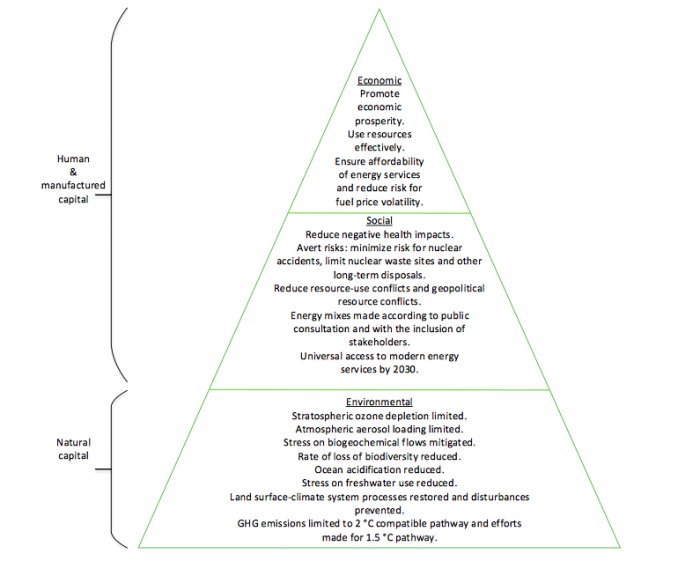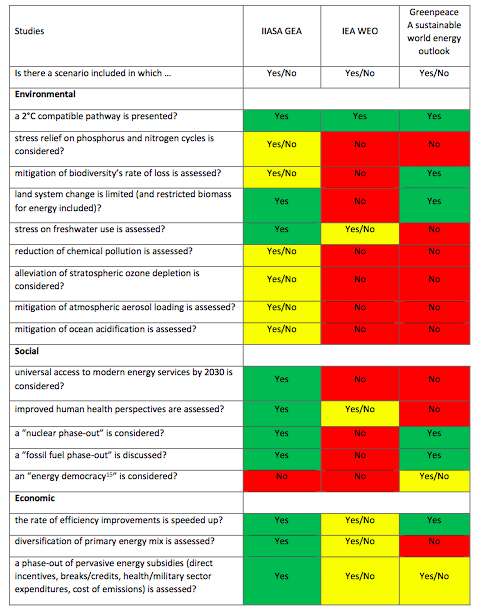
Although a great deal of attention has rightly been paid to greenhouse gas (GHG) emissions and climate change, there are other equally important planetary boundaries that must also be accounted for if there is to be a fair transition toward the sustainability of global energy systems. The Paris Agreement is indeed a landmark accord that provides a meaningful goal for limiting global GHG emissions, but energy systems are so deeply interwoven into society that the impacts of change must be viewed more holistically, as should the advantages and disadvantages that are experienced economically, environmentally, and socially.
Energy scenario modeling is a good method of outlining the kinds of changes that can be made to energy systems and can be valuable to a number of stakeholders. In essence, modeling can provide visions of the future that can then be interpreted, tested, and discussed critically to determine their desirability. Modeling can also serve to reduce uncertainty about the future through exposing the most plausible, visible, or potentially disruptive changes to society. In this regard, it can aid in preventing harm to society, and possibly highlight economic opportunities.
At the same time, energy system modeling can be driven by vested interests. For this reason, the transparency of the myriad of assumptions (economic, technological, etc.) used in modeling is paramount. To have a meaningful discourse about energy futures, modeling methods and assumptions need to be discussed hand-in-hand with the results.
This study examined how influential energy system scenarios have represented sustainability. One motivation of this work was a concern that future energy scenario modeling focused too narrowly on the concept of climate change mitigation, despite the importance of this issue. Therefore, the first aim was to consider the concept of sustainability in energy systems in a manner that adheres to a broader set of guardrails, respecting all relevant planetary boundaries and sustainability principles.

Figure 1. Proposed hierarchical framework for assessing the sustainability of global energy scenarios. Republished with permission from Elsevier from: https://doi.org/10.1016/j.rser.2018.03.079
Secondly, a sustainability hierarchy was proposed (Figure 1) for the purpose of scrutinizing future global energy scenarios more comprehensively as well as the transition towards sustainability proposed in each. A third aim was to investigate whether several influential global energy scenarios had adequately adhered to the proposed hierarchy and to suggest ways that the guardrails could be operationalized during the creation of energy system scenarios. This included the development of a sustainability checklist (Table 1) that could be applied by future energy system modelers to their own work.

Table 1. Sustainability checklist for global energy scenarios. Green: Explicitly stated, yellow: not fully disclosed, red: not mentioned. Credit: Michael Child
The results suggest that the planetary boundary framework has yet to be fully incorporated into global energy scenario modeling, where the emphasis has been almost solely on CO2 emission mitigation. Stress on biochemical flows, land use change, biodiversity, oceans, and climate systems are often neglected, while social and economic aspects — such as limiting air pollution, providing universal access to modern energy services, and improving energy efficiency by electrification of energy services — are emerging as new paradigms in these frameworks. However, ethical choices, such as current and future generations’ access to preserved ecosystems, an avoidance of energy resource risks, preventing resource use conflicts, and negative impacts on humans caused by energy extraction and use are not usually discussed or justified in energy scenario modeling.
All investigated global energy transition scenarios failed to adequately describe the critical roles of flexibility in future energy systems caused by high shares of renewable energy, especially by storage, grids, demand response, supply-side management, and sector coupling. They also did not adequately incorporate the concept of resilience in socio-ecological systems.
It was also determined that the transparency of global energy system scenarios was lacking and that this ultimately affects their credibility. In the end, a lack of transparency limits the quality of the essential discourse needed to determine global energy futures.
However, according to this analysis, fully renewable energy system scenarios fulfill a set of environmental, socio-economic, and ethical sustainability objectives in the most comprehensive manner. For this reason, fully renewable energy system scenarios should thus be regarded as real policy options and set as references for alternative options.
Energy system models should show how scenarios achieve sustainability in a broader sense. This should not be an unmanageable burden if the hierarchical framework proposed in this work is observed during scenario design. Importantly, policymakers should now have a more complete framework upon which to judge the quality of various energy system scenarios beyond the current focus on GHG emissions. Indeed, it should also be possible to see past possible vested interests that too often are present in the modeling of future energy system scenarios. For government officials and lawmakers, if a more broad and comprehensive criterion of sustainability is adhered to throughout the process of policymaking, it should not only be possible to achieve goals related to climate change mitigation, but also create a more resilient energy system. This would fulfill a valid social contract with future generations, who will also be the beneficiaries of such a long-lived socio-technical system.
These findings are described in an article entitled Sustainability guardrails for energy scenarios of the global energy transition, recently published in the journal Renewable and Sustainable Energy Reviews. This work was conducted by Michael Child, Otto Koskinen, Lassi Linnanen, and Christian Breyer from the Lappeenranta University of Technology, in Lappeenranta, Finland.









